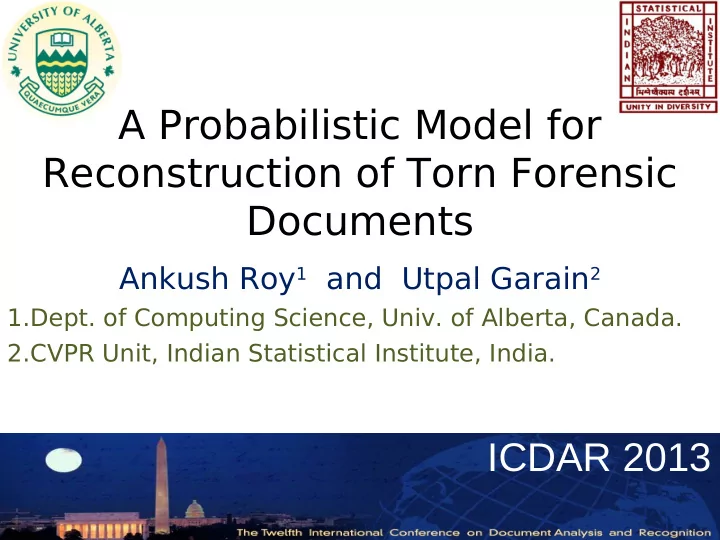

A Probabilistic Model for Reconstruction of Torn Forensic Documents Ankush Roy 1 and Utpal Garain 2 1.Dept. of Computing Science, Univ. of Alberta, Canada. 2.CVPR Unit, Indian Statistical Institute, India. ICDAR 2013
Background
Background
Analogy • Reconstruction of torn documents – 2-D pictorial cardboard puzzles (Jigsaw puzzle) • Presence of irregular shapes • Existence of missing pieces – Panoramic image reconstruction • Assumption of overlapping regions
Our Method: Exploit Every Possible Thing Seed
The Model • I k ={i 1 , i 2 , …, i nk } • Set of sub-images at k-th iteration i-th piece has n i number of edges • E k is the total number of edges at k-th iteration • E k − n • No. of max. arrangements at k-th step i P n i • Let these arrangements are: E k − ni P n i ) t A k =( t A k ∣ t ∈ 1,2,... , • How to compute probability of every arrangement
The Model m • Let be the m-th edge of i-th piece s i • Let s i be the seed and s j be one of the other pieces • P s is the probability of shape matching • P c is the probability of content matching • Is probability that m -th side of s i to be stitched with l - th side of s j l ∣ s i m ) P c ( s j l ∣ s i m ) α m = argmax P s ( s j j= 1,2,... ,nk;i ≠ j n i • So the probability of an t )= ∏ p ( A k α m t A k arrangement ( ) is m= 1
The Model • Shape statistics • Polygonal approximation [Bhowmick, IEEE PAMI 29(9), 2007] • Horizontal distance is used to align individual sides [Lowe, IJCV, 2004] • Image Statistics • Texture close to edges are considered • Ideas borrowed from Cho et. al [The Patch Transform, IEEE PAMI 2010]
Convergence • Lemma: • In k+1 iteration, |I k+1 |<=|I k | • Proof: • In k-th iteration, n i edges of s i will find match with another n i edges from |I k |-1 images. If these n i images are • Distinct : |I k+1 | = |I k | - n i • The same image: |I k+1 | =|I k | - 1 • No match found: |I k+1 | = |I k | • Proved • Constraint to damp explosion • Choose n i from non-boundary (non-smooth) edges only
Experiments • Datasets were developed with help from Forensic Experts • Two sets • Unintended tearing • 100 images • Average no. of pieces: 12 • Intended tearing • 100 images • Average no. of pieces: 8
Evaluation • Two strategies • Qualitative • Human judged • Binary decision (could recognize or not) • Quantitative • Borrowed from 3-D reconstruction technique [CVPR 2006] • Registration of actual and reconstructed images • Distance of their intensities • Two environments • With cue • Information of intentional tearing is provided • Without cue
Results • Qualitative [Averaged over 10 runs] Without cue With Cue 82.9% 77.9% • Quantitative (Intensity level difference of registered images), [Seitz et. al. CVPR 2006] Percentile Without Cue With Cue 50 th 11 11 75 th 17 19 90 th 22 43
Results
Results
Conclusions • Contribution • Assumption of shape regularity is not needed • Torn pieces could of any size and shape • Final arrangements are ranked according to their likelihood
To be explored • Incorporation of missing pieces in the model • Handling of large number of small pieces • Evaluation of image reconstruction
Recommend
More recommend